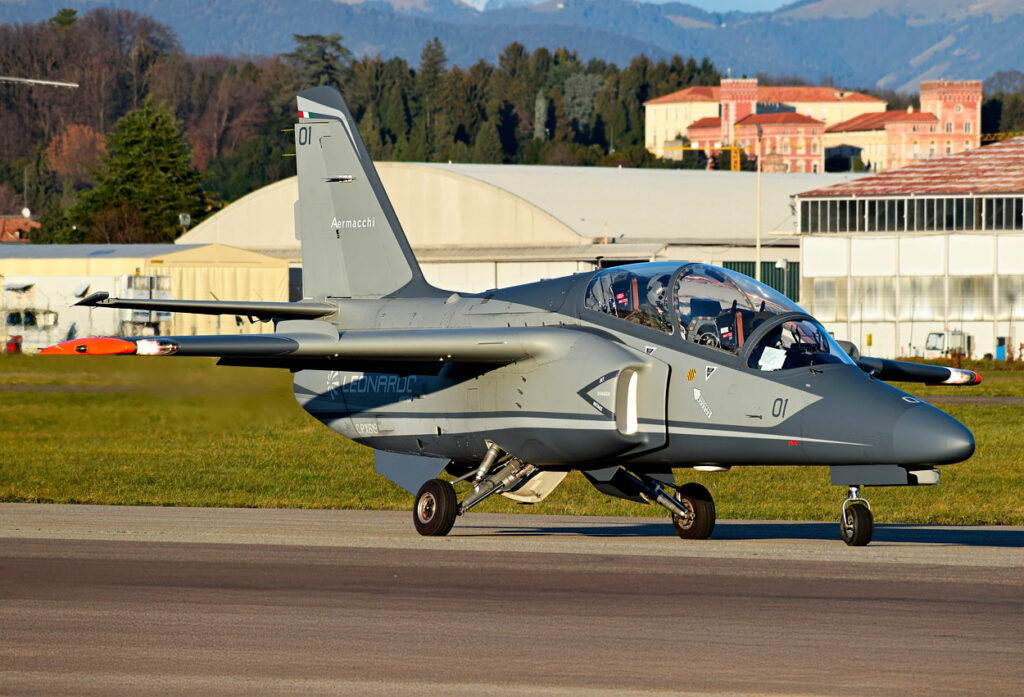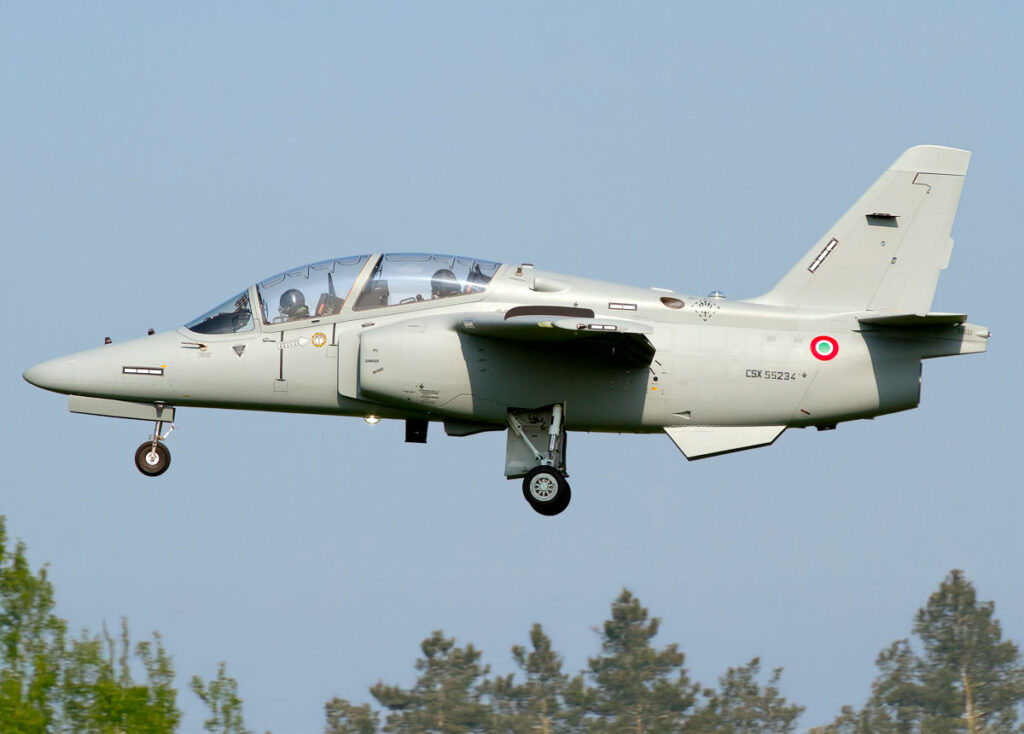The Leonardo M-345 is a high-efficiency jet trainer featuring advanced avionics, cost-effective operation, and excellent performance for military training.
The Leonardo M-345 is an advanced jet trainer designed to meet modern military pilot training needs. Manufactured by Leonardo S.p.A., the aircraft bridges the gap between turboprop trainers and advanced jet trainers. Powered by a Williams FJ44-4M-34 turbofan engine, it produces 15.12 kN (3,400 pounds) of thrust. The M-345 has a top speed of 740 km/h (460 mph) and an operational ceiling of 12,200 meters (40,000 feet). With a range of 1,410 kilometers (876 miles), it is suitable for a variety of training missions.
The cockpit features a glass display system, HOTAS controls, and modern avionics, allowing trainee pilots to familiarize themselves with fighter aircraft systems. Its design emphasizes low operating costs, utilizing digital maintenance and efficient fuel consumption. First flown in December 2016, the M-345 is actively used by the Italian Air Force and other nations. It combines simplicity and advanced capabilities for an effective training solution.
History of the development of the Leonardo M-345
The development of the Leonardo M-345 was driven by the need for an affordable yet advanced jet trainer capable of replacing older platforms and meeting contemporary training requirements. During the late 1990s and early 2000s, the demand for high-efficiency training systems increased as air forces sought to reduce costs while preparing pilots for modern aircraft. Older trainers, such as the MB-326 and MB-339, were becoming outdated, prompting the search for replacements.
Leonardo initiated the M-345 program in the early 2010s as part of its effort to modernize its trainer portfolio. The goal was to create a jet trainer that combined the simplicity of turboprops with the performance and systems of advanced jets. This approach aimed to bridge the gap between basic flight training and advanced operational training.
The M-345 traces its lineage to the SIAI-Marchetti S.211, a basic jet trainer developed in the 1980s. The S.211 served as the conceptual basis for the M-345, with significant upgrades to its structure, avionics, and propulsion. By integrating modern technologies, Leonardo aimed to create an aircraft that was efficient, reliable, and versatile. The Italian Air Force emerged as the primary launch customer, seeking a replacement for its aging fleet of MB-339 trainers.
On December 29, 2016, the M-345 conducted its maiden flight from Leonardo’s facility in Venegono, Italy. This milestone marked the culmination of years of design, engineering, and testing. Following successful initial trials, the Italian Air Force placed an order for 18 units to replace its MB-339 fleet. The NATO designation for the aircraft is M-345 HET (High Efficiency Trainer), emphasizing its cost-effective and advanced capabilities.
The aircraft’s development aligned with broader trends in military aviation, where cost reduction and operational efficiency became paramount. With a modular design and advanced avionics, the M-345 reflects Leonardo’s commitment to delivering solutions tailored to the needs of modern air forces. The M-345’s export potential further highlights its relevance, with interest from several countries seeking affordable yet capable jet trainers.

Design of the Leonardo M-345
The Leonardo M-345 features a streamlined design optimized for training efficiency and operational versatility. Its airframe is constructed primarily from lightweight aluminum alloys and composite materials, balancing durability with reduced weight. The aircraft measures 9.85 meters (32.3 feet) in length, has a wingspan of 8.47 meters (27.8 feet), and stands 3.74 meters (12.3 feet) tall. These dimensions provide an optimal size for both maneuverability and stability during training missions.
The cockpit is equipped with a digital glass display system, including three multifunctional displays, a head-up display (HUD), and HOTAS (hands-on throttle and stick) controls. These systems replicate those found in operational combat aircraft, enabling trainee pilots to familiarize themselves with modern fighter avionics. The ejection seats are Martin-Baker Mk16 models, providing high levels of safety.
The propulsion system is a Williams FJ44-4M-34 turbofan engine, which generates 15.12 kN (3,400 pounds) of thrust. This engine is known for its reliability and efficiency, contributing to the M-345’s low operating costs. The aircraft’s internal fuel capacity, supplemented by optional external tanks, ensures sufficient range for extended training sorties.
Aerodynamically, the M-345 incorporates a low-wing monoplane configuration with a swept wing design. This design enhances performance in various flight regimes, from low-speed handling to high-speed operations. The aircraft’s winglets further improve aerodynamic efficiency and stability. However, the absence of advanced stealth features limits its suitability for combat scenarios.
Maintenance requirements for the M-345 are minimized through digital monitoring systems, which provide real-time diagnostics and predictive maintenance capabilities. This reduces downtime and lowers lifecycle costs, a critical advantage for training fleets. The aircraft’s modular systems allow for rapid replacement of components, further enhancing operational readiness.
While the M-345 excels in training applications, its payload limitations and lack of advanced weapon systems restrict its combat utility. However, for its intended role as a trainer, the M-345 delivers excellent performance and cost efficiency.
Performance of the Leonardo M-345
The Leonardo M-345 is powered by the Williams FJ44-4M-34 turbofan engine, a compact and efficient powerplant producing 15.12 kN (3,400 pounds) of thrust. This engine enables the aircraft to achieve a top speed of 740 km/h (460 mph) and climb at a rate of 22.2 meters per second (4,370 feet per minute). Its operational ceiling is 12,200 meters (40,000 feet), providing the altitude flexibility necessary for advanced training missions.
With an internal fuel capacity of 700 kilograms (1,543 pounds) and optional external tanks, the M-345 offers a maximum range of 1,410 kilometers (876 miles). This range allows for extended sorties without the need for frequent refueling. The aircraft’s endurance and efficiency make it a cost-effective platform for pilot training programs.
The M-345’s agility and aerodynamic design enhance its performance across various flight profiles. The aircraft’s low-wing monoplane configuration, combined with winglets, provides stability and maneuverability. Its ability to operate at low speeds and high angles of attack ensures that trainee pilots can practice advanced maneuvers safely.
In comparison to its competitors, such as the Aero L-39NG and the KAI KT-1, the M-345 stands out for its modern avionics and cost efficiency. While the L-39NG offers similar performance, the M-345’s digital systems and lower maintenance requirements give it an operational advantage. Similarly, the KT-1’s turboprop engine limits its speed and altitude capabilities, making the M-345 a superior choice for jet trainer roles.
Variants of the Leonardo M-345
The primary variant of the Leonardo M-345 is the M-345 HET (High Efficiency Trainer). This model serves as the baseline configuration, designed for advanced military pilot training. It features modern avionics, a reliable turbofan engine, and cost-effective operation.
Future variants of the M-345 may include configurations tailored for light attack roles. These versions would incorporate hardpoints for carrying munitions and sensors, expanding the aircraft’s operational flexibility. Additionally, export variants are expected to include modifications based on customer requirements, such as enhanced communication systems or customized avionics.
The M-345’s modular design allows for easy adaptation to various roles and missions. This versatility ensures its relevance in diverse operational scenarios, from basic flight training to tactical support missions.

Military use and combat of the Leonardo M-345
The Leonardo M-345 is primarily employed as a military training aircraft, designed to prepare pilots for advanced fighter operations. Equipped with modern avionics and a reliable propulsion system, it serves as an efficient platform for both basic and advanced training missions. The aircraft’s two-seat configuration enables instructors and trainees to operate collaboratively, enhancing the learning process.
Armament options for the M-345 are limited due to its primary role as a trainer. However, the aircraft can be equipped with external hardpoints to carry lightweight munitions, such as practice bombs and rocket pods, for training purposes. This capability allows trainees to gain experience in weapon deployment without the need for dedicated combat platforms.
The Italian Air Force is the primary operator of the M-345, using it to replace its aging MB-339 trainers. The aircraft has not been used in active combat, as its design prioritizes training efficiency over combat capabilities. However, its potential for light attack roles could expand its operational scope in the future.
Export opportunities for the M-345 are growing, with interest from several countries seeking affordable and modern training solutions. The aircraft’s modularity and low operating costs make it an attractive option for air forces with limited budgets. As of now, the M-345 remains in active production, with deliveries continuing to meet domestic and international orders.
The Leonardo M-345 offers a modern solution for military pilot training, combining advanced avionics with cost-effective operation. Its performance, reliability, and modular design ensure its relevance in training missions. While its combat utility is limited, the M-345 excels in its intended role, providing air forces with an efficient and versatile training platform.
Back to the Trainers section.